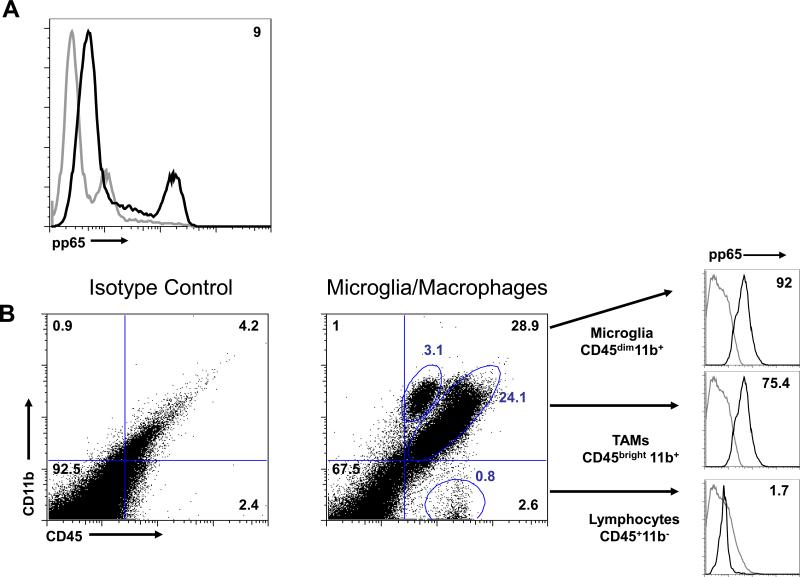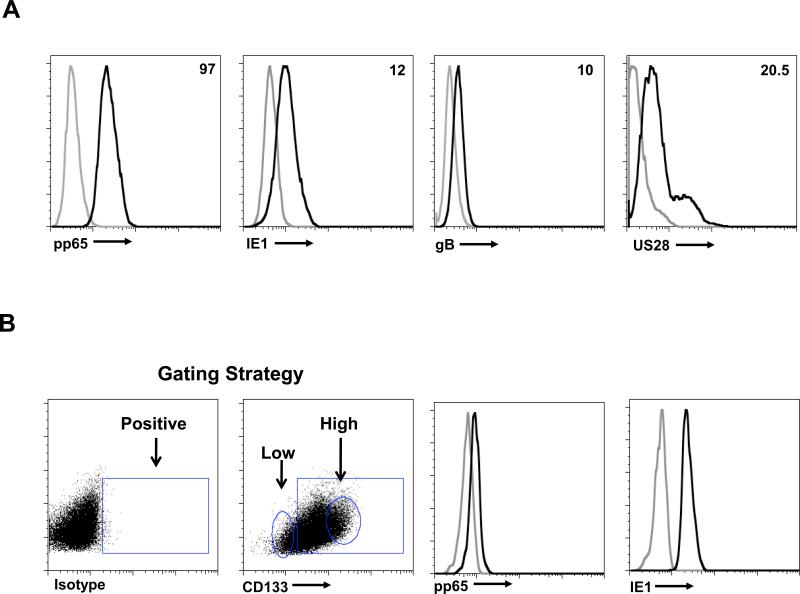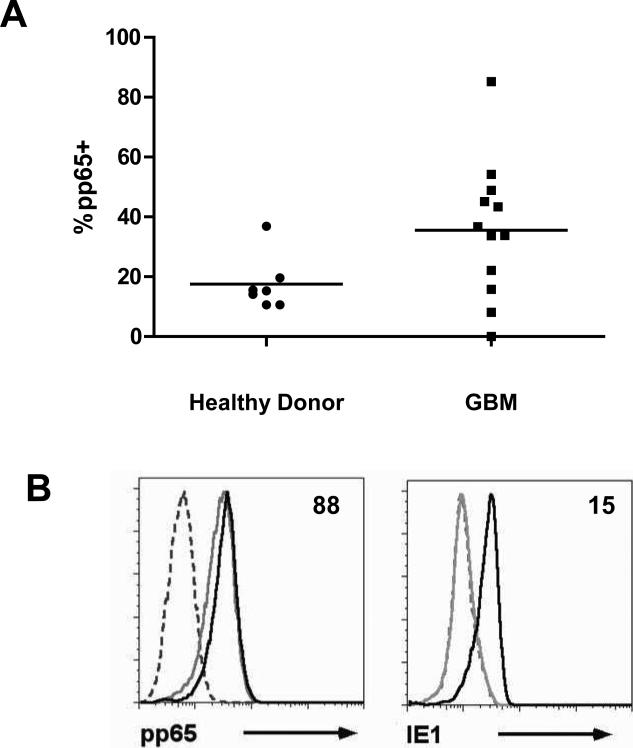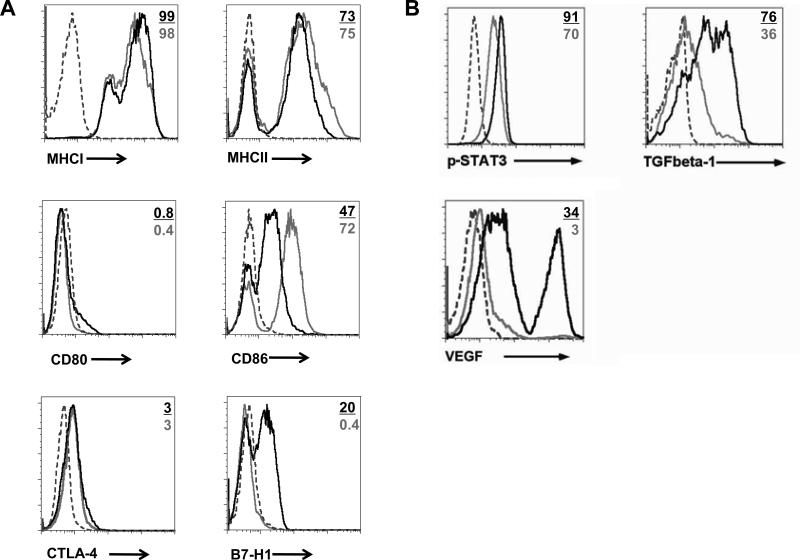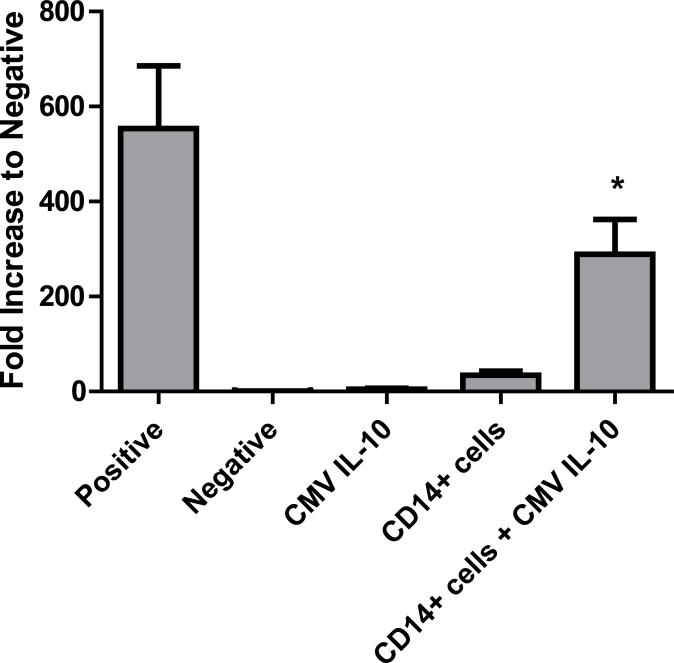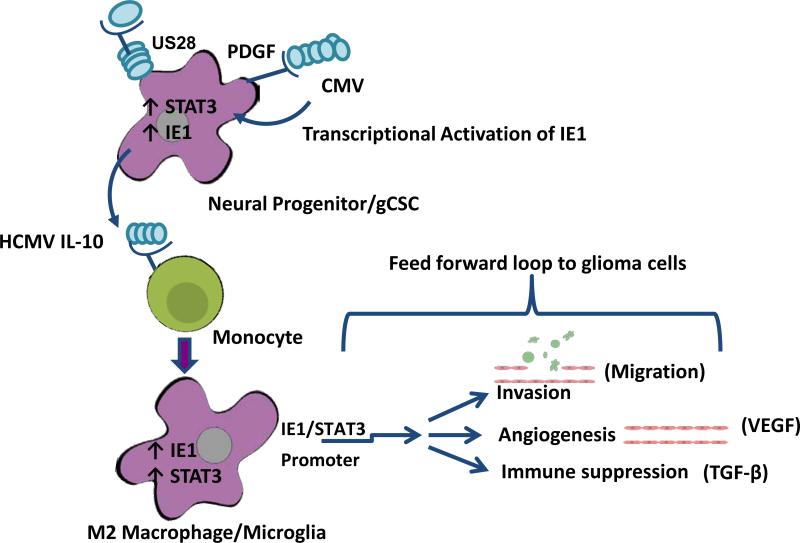Abstract
Purpose
CMV has been ubiquitously detected within high-grade gliomas, but its role in gliomagenesis has not been fully elicited.
Experimental Design
Glioblastoma multiforme (GBM) tumors were analyzed by flow cytometry to determine CMV antigen expression within various glioma-associated immune populations. The gCSC CMV IL-10 production was determined by ELISA. Human monocytes were stimulated with recombinant CMV IL-10 and levels of expression of p-STAT3, VEGF, TGF-β, viral IE1 and pp65 were determined by flow cytometry. The influence of CMV IL-10 treated monocytes on gCSC biology was ascertained by functional assays.
Results
CMV demonstrated a tropism for macrophages (MΦs)/microglia and CD133+ gCSCs within GBMs. The gCSCs produce CMV IL-10, which induces human monocytes (the precursor to the CNS MΦs/microglia) to assume an M2 immunosuppressive phenotype (as manifested by down modulation of the major histocompatibility complex and costimulatory molecules) while up regulating immune inhibitory B7-H1. CMV IL-10 also induces expression of viral IE1, a modulator of viral replication and transcription in the monocytes. Finally, the CMV IL-10-treated monocytes produced angiogeneic VEGF, immunosuppressive TGF-β, and enhanced migration of gCSCs.
Conclusions
CMV triggers a feed-forward mechanism of gliomagenesis by inducing tumor-supportive monocytes.
Keywords: Glioblastoma, cytomegalovirus, CMV IL-10, pp65, IE1, cancer stem cells, macrophages, immunosuppression, tumorigenicity, signal transducer and activator of transcription 3
INTRODUCTION
In the United States, the prevalence of CMV in the adult population is 50-85% (1). As such, serum CMV positivity is common throughout the general population and CMV itself remains in an asymptomatic, latent state in healthy immune competent individuals. CMV has been shown to be present in glioma tumor cells but not in surrounding normal brain, or other neuropathologies (2-4). Malignant gliomas have been postulated to arise from transformed neural progenitor cells/glioma cancer stem cells (gCSCs) (5). These cells are permissive to CMV infection (6), resulting in abnormal differentiation (7) or inhibition of differentiation into normal astrocytes (8). The platelet-derived growth factor-alpha receptor (PDGFR-α), expressed on neural progenitor/stem cells in the adult subventricular zone (9), is required for CMV infection as a result of binding the CMV envelope protein gB, resulting in phosphoinositide-3-kinase (PI3K) signaling (10). Blockade of PDGFR-α or its functional activity inhibits internalization and gene expression of CMV (10).
The etiological role of CMV in the genesis of gliomas is an area of significant ongoing controversy. Concurrent virology research has shown that CMV infectivity could predispose cells to oncogenesis. For example, US28, a chemokine receptor encoded by CMV that binds chemokines and activates various proliferation pathways, induces a proangiogenic and transformed phenotype in glioblastoma cells by up-regulating vascular endothelial growth factor (VEGF). These US28-expressing cells promote tumorigenesis when injected into mice (11), probably mediated by the signal transducer and activator of transcription 3 (STAT3)(12). Additionally, the CMV immediate-early genes (UL123/122) that encode proteins crucial for initiating the viral replication cycle (13) have been investigated as a potential etiology for modulating an oncogenic phenotype in gliomas. However, this gene expression resulted in a variable response among various glioma lines–in some instances enhancing glioma cell proliferation while leading to growth arrest in others (14). CMV infection has also been shown to induce phosphorylation of focal adhesion kinase, which can increase human malignant cell invasiveness (15), and the CMV IE2 protein has been shown to interact with histone deacetylase 2, resulting in increased transcriptional activity (16). Finally, CMV has been shown to alter microRNAs (17), which can play an important role in the development of cancers (18, 19). Cumulatively, these data suggest that the presence of CMV is not merely an epiphenomenon.
It is also unclear whether the tumor immunosuppressive environment supports susceptibility to infection with CMV or whether CMV induces tumor-mediated immune suppression. As a mechanism to evade immune detection, the CMV antigen pp65 prevents the expression of other CMV antigens in the context of the MHC, inhibits NK cell toxicity, and degrades the HLA-DR alpha chain (20). In murine model systems, MΦs infected with murine CMV down regulate MHC class II molecules while transcriptionally inhibiting proinflammatory IFN-γ induction, essentially rendering these cells non-functional (21). CMV also encodes a consensus sequence of IL-10 (CMV IL-10) (22) that can bind to the human IL-10 receptor and activate STAT3 (23, 24), a key molecular hub for tumorigenesis (25) and immune suppression (26), especially in gliomas (27-30). CMV IL-10 has been found to inhibit both proliferation and the production of proinflammatory cytokines in monocytes (31), the myeloid precursors to MΦs and microglia (32).
The STAT3 pathway is active in gCSCs (33, 34), as determined by measurements of its activated form, p-STAT3. In addition, it can be induced in diverse immune cells in the tumor microenvironment (35), which down regulates their antitumor immune responses. Specifically, p-STAT3 has been shown to suppress MΦ activation and to limit MΦ inflammatory responses (36), reduce natural killer (NK) cell and neutrophil cellular cytotoxicity, and reduce the function of dendritic cells (35). Tumor-associated MΦs/microglia become polarized via the STAT3 pathway toward the immunosuppressive and tumor-supportive phenotype (M2) that contributes to angiogenesis and tumor invasion (37). The role of STAT3 in mediating the immunosuppressive MΦs is further supported by studies in the a murine model of endogenously arising heterogeneous gliomas that show a marked intratumoral influx of MΦs, a negative prognosticator for long-term survival (38).
Considering the parallel strategies of immune evasion seen in GBM and CMV infection coupled with the high frequency of identification of the virus in GBM tissue samples, we wanted to investigate whether viral activity directly contributes to the immunosuppressive environment. We therefore hypothesized that CMV infection within gCSCs potentiates tumor-mediated immune suppression by inducing the STAT3 pathway and subverts the monocytes lineage to glioma-propagating phenotype.
Materials and Methods
Human Tissues and PBMCs
This study was approved by the institutional review board of The University of Texas M.D. Anderson Cancer Center (M.D. Anderson) and conducted under protocol #LAB03-0687. PBMCs (30-50 mL) were isolated by centrifugation on a Ficoll-Hypaque density gradient (Sigma-Aldrich, St. Louis, MO), washed with PBS, and treated with red cell lysis buffer as necessary. Tumors were washed in RPMI medium and dissected to remove blood products and surrounding non-tumor brain. Remaining bulk tumor was then enzymatically and mechanically digested using Tumor Cell Digestion Solution (Panomics, Fremont, CA) at 37° C and filtered through a 100 μM membrane. The filtrate was pelleted by centrifugation and then resuspended in Percoll at a density of 1.03 followed by a 1.095 density underlay. FACS buffer (PBS + 2% BSA) was gently overlayed on the cell suspension, and the completed gradient was centrifuged for 15 minutes at 1200g with no brake. Cells were harvested from between the gradients, washed in FACS buffer (PBS + 2% BSA), and treated with red cell lysis buffer (Sigma-Aldrich). Cells were re-filtered and washed as necessary. Cell viability was determined using a ViCell 1.01 (Beckman Coulter, Brea, CA).
Human Glioma Cancer Stem Cell Derivation
The gCSC population has been previously described and characterized based on the criterion of in vivo tumorigenic potential, pluripotent potential, limiting dilution assays, and cytogenetic characterization, (34, 39-41). Supernatants from the gCSCs were collected and stored at -20° C for use as conditioned medium and ELISA analysis. The gCSCs were cultured in vitro with neurosphere medium consisting of Dulbecco's modified Eagle's medium/F-12 medium containing antibiotics, B27 growth factor, and 20 ng/mL of both epidermal growth factor (EGF) (Sigma-Aldrich) and fibroblast growth factor 2 (FGF-2) (Sigma-Aldrich).
Human Microglia/MΦs Isolation and Characterization
Microglia cells were purified using a Percoll (GE Healthcare, Uppsala, Sweden) gradient (42) and phenotyped as previously described (43).
Derivation and Isolation of Purified CD14+ Cells
PBMCs were prepared from healthy donor blood (Gulf Coast Blood Center, Houston, TX) by centrifugation on a Ficoll-Hypaque density gradient (Sigma-Aldrich). Harvested PBMCs were purified with CD14 magnetic beads (MACS, Auburn, CA) and passed through an MS Column (MACS)) to purify CD14+ monocytes. The percentage of CD14+ cells was determined to be ~95% by flow analysis. Purified monocytes were cultured in serum-free DC medium (Cell Genix, Antioch, IL). Recombinant CMV IL-10 was obtained from R & D Systems (Minneapolis, MN).
Cell Lines and Culture
Glioma cell lines U87, U251, D54 were cultured in Dulbecco's DMEM F/12 media containing antibiotics and 10% FBS. The leukemia cell line HL-60 was cultured in RPMI medium supplemented with 10% FCS, 2mM L-Glutamine, 1mM Na Pyruvate, 0.1mM Non Essential Amino Acids, 10mM HEPES (pH 7.04), and 1× Penicillin/Streptomycin.
Surface and Intracellular Staining of Cells
Ex vivo tumor cells and matched PBMCs in single cell suspension were Fc blocked with human IgG (R&D Systems), except for the gCSCs used for US28 studies. Working concentrations of appropriate antibodies to surface markers were added (CD133 [MACS], CD45, CD11b, CD3, CD19, CD14, [BD Biosciences, San Diego, CA] and CD163 [R&D], US28 [Santa Cruz Biotechnology, Santa Cruz, CA]) and incubated with the cells for 30 minutes in the dark at 4°C. A secondary antibody was required for US28 detection (Invitrogen, Carlsbad, CA). Matched isotype controls were included for each sample. Cells were pelleted by centrifugation and washed, followed by suspension in fix/perm buffer (eBioscience, San Diego, CA) for two hours in the dark at 4°C. Cells were rewashed with FACS buffer and 1X permeabilization buffer (eBioscience), and working concentrations of antibodies to intracellular proteins (IE1 [Millipore, Temecula, CA], pp65 [Pierce Biotechnology], gB [AbCam, Cambridge, MA] and pSTAT3 [BD Biosciences]) were added to the appropriate wells. Cells were washed and resuspended in FACS buffer for data acquisition (FACSCaliber Becton Dickinson, San Diego, CA). Data were analyzed with Flow Jo software (TreeStar, Ashland, OR).
ELISA
Supernatant medium obtained 24 hours after passage of the gCSCs was measured for CMV IL-10 as described (R&D Systems). The CMV IL-10 capture antibody (Leinco Technologies, St Louis, MO) was used at 2.0 ug/mL with biotinylated detection antibody (R&D Systems) at 0.5 ug/mL. The lack of cross reactivity to human IL-10 was verified up to a concentration of 2ng/mL.
Cytokine Microarray
MACS-purified CD14+ monocytes were seeded at 1 × 106 on 24-well plates for 2 hours and then either left untreated or stimulated with HCMV IL-10 (10 ng/ml) for 48 hours at 37°C. After that, the supernatants were harvested, frozen at -80°C, and shipped to RayBiotec© for L-507 antibody array and densitometry analyses.
Cell Migration Assay
The culture well inserts provided with a membrane pore size of 8 μM (BD Biosciences) were seeded with 200,000 gCSCs/insert and placed in 24-well culture plates containing either serum-free DC medium (Cell Genix; negative control), medium with 10% FBS (positive control), medium supplemented with CMV IL-10, or medium conditioned by monocytes cultured with or without CMV IL-10 for 24h. After overnight culture, all the cells that migrated through the membrane into the experimental medium were collected, pelleted with centrifugation, re-suspended in a unit volume, and counted based on Trypan blue exclusion.
Statistical Analysis
The distribution of each continuous variable was summarized by its mean, standard deviation and range. The distribution of each categorical variable was summarized in terms of its frequencies and percentages. Continuous variables were compared between groups by a two-sample t-test if the data were normally distributed; otherwise a Wilcoxon rank sum test was used (44). Simple linear regression was used to assess the relationship between variables. P values less than 0.05 were considered to be statistically significant. Error bars represent SD.
RESULTS
CMV Expression within GBM-associated Immune Cells
To begin to investigate the relationship between CMV-infected gCSCs and intratumoral immune cells that may also harbor CMV, single cell suspensions of newly diagnosed GBMs were analyzed (n=5). CMV pp65 antigen expression was present in a subset of cells within these GBMs (Fig. 1A). Further analysis revealed distinct immune subpopulations that expressed pp65. Based on CD11b and CD45 expression, we found that both MΦs and microglia commonly expressed pp65; however, intratumoral T and B cells did not express pp65 (Fig. 1B). This data would indicate that CMV has a tropism for distinct immune cell populations within GBM.
Fig. 1. CMV antigen expression has a tropism for subsets of immune cells within GBMs.
(A) Flow cytometry staining of GBM in single cell suspension shows only a subset of cells are positive for the CMV antigen pp65. The percentage of cells positive is denoted in the upper right quadrant of the histogram. (B) Flow cytometry gating strategy used to distinguish cells of monocyte lineage (such as microglia and MΦs [TAMs]) and lymphocytes based on CD11b and CD45 expression profile and intracellular staining of pp65. Each phenotype was separately analyzed for pp65 expression, as indicated by the histograms. The gray line represents the isotype control, and the black line shows the cells with positive staining for pp65. Percentages of cells are denoted in each quadrant and by their respective gates. The percent positive compared to the isotype control is shown in the right upper quadrant in the pp65 sub analysis panel. This data shown here is a representative of the five newly diagnosed glioblastoma samples analyzed.
CMV Activity within gCSCs
Because gCSCs are rare in ex vivo glioblastoma tissue, we used a panel (n=4) of well-characterized gCSCs (34, 40, 41) to further evaluate CMV activity. All gCSCs expressed pp65, IE1, gB, and US28 (a representative example is shown in Fig. 2A). Additionally, glioma cell lines such as U-87, U251, and D-54 express these CMV antigens (Supplementary Fig. 1). Further characterization of the CD133high population compared with CD133low population within the gCSCs (n=4) demonstrated higher levels of CMV IE1 in the CD133high gCSC population relative to the CD133low gCSC population (Fig. 2B). To assess whether the gCSCs are elaborating CMV IL-10, gCSC supernatants were tested by ELISA. All of the gCSCs (n=4) produced CMV IL-10 at a range of 5.62-111.11 pg/mL/106/day but no human IL-10.
Fig. 2. CMV antigen expression is enhanced in CD133 gCSCs.
(A) Representative flow cytometry analysis of a gCSC sample stained for intracellular expression of CMV antigen expression of pp65, IE1, and gB as well as surface expression of US28. The percentage in the upper quadrant is positive cells relative to isotype. Similar data were obtained in three other gCSCs. (B) Flow cytometry gating strategy for CD133-positive gCSCs demonstrating the rectangular gate-capturing cells staining positively for CD133 relative to the isotype control. The round gates capture the CD133low and CD133high phenotypes. The shift in histograms (solid black line) reflects increased CMV protein expression in the CD133high population relative to the CD133low (grey line).
CMV IL-10 induces CMV Transcriptional Activity in Monocytes
There was a trend of elevated CMV pp65 expression levels in the PBMCs of the patients with newly diagnosed GBM who had a mean expression level of 33.6 ± 25.2% (range: 0-85; n=8) in comparison to normal volunteers, who had a mean expression level of 17.5 ± 8.4% (range: 10.6-36.9; n=7; Wilcoxon two-sided test, P=0.27)(Fig. 3A). In a sub-analysis of peripheral blood monocytes isolated from either GBM patients (n=3) or normal donors (n=4), precursors to glioma-associated MΦs and microglia, we found that the monocytes express the CMV antigen pp65 but relatively low IE1 (Fig. 3B). However, when these peripheral blood monocytes were treated with CMV IL-10, there was induced the expression of CMV IE1 in the monocytes, suggesting an increase in transcriptional activity of the CMV within this subpopulation upon exposure to CMV IL-10.
Fig. 3. CMV IL-10 induces CMV transcriptional activity in monocytes.
(A) Expression levels of pp65 in the PBMCs from GBM patients were found to be higher than in PBMCs from healthy donor controls although this was not statistically significant. (B) Purified CD14+ monocytes demonstrated expression of pp65 but relatively low levels of IE1. The dashed line represents isotype control and the gray line untreated monocyte staining. Upon exposure of the monocytes to CMV IL-10 as shown by the black line, there was up regulation of CMV IE1 but no further increase in pp65 expression.
CMV IL-10 Subverts Monocytes to an Immune Suppressed Phenotype
To ascertain whether CMV IL-10 can induce naïve monocytes to an immunosuppressive phenotype, exogenous CMV IL-10 was co-cultured with human CD14+monocytes that were isolated from peripheral blood of normal donors (n=4). In CD14+ monocytes exposed to CMV IL-10, there was a relative down regulation of MHC II and the costimulatory molecule CD86 but up regulation of the co-stimulatory inhibitory molecule B7-H1 (Fig. 4A). The exposure of the monocytes to CMV IL-10 also enhanced intracellular expression of p-STAT3, TGF-β1, and VEGF (Fig. 4B). To comprehensively analyze and potentially gain new insights into CMV IL-10-induced monocyte-elaborated cytokines, we used RayBiotech© cytokine microarrays as a screen to evaluate candidates that could reciprocally enhance gCSC gliomagenesis (Supplementary Table 1). This CMV IL-10 induced immune suppressive monocyte phenotype would be anticipated to enhance gliomagenesis.
Fig. 4. CMV IL-10 induces an immune suppressive phenotype in monocytes.
(A) In monocytes exposed to CMV IL-10 for 24 hours, there was down modulation in percentage of monocytes expressing MHC II and CD86 with up regulation of the costimulatory inhibitory molecule B7-H1. (B) The exposure of the monocytes to CMV IL-10 caused an up regulation of intracellular p-STAT3, TGF-β1, and VEGF. The dashed line represents the isotype control, the gray line shows monocytes cultured without CMV IL-10, and the black line shows monocytes cultured in medium containing CMV IL-10 at a dose of 10ng/mL. Analysis was performed after 48 hours in culture. This experiment was done with triplicate donor monocytes with similar results. The number in the right upper quadrant denotes percentage of positive cells upon exposure to CMV IL-10 (black) and the percentage of positive cells without exposure to CMV IL-10 (grey )
CMV IL-10-Exposed Monocytes Enhance gCSC Migration
To functionally assess whether CMV IL-10 could induce the monocytes to secrete factors that would enhance gCSC migration, the gCSCs were assessed in standard migration assays upon exposure to supernatant culture medium from the CMV-IL10-treated monocytes. There was a 230-fold increase in gCSC migration relative to the control (CMV IL-10-containing medium alone) and a 40-fold increase in gCSC migration relative to exposure to supernatant medium from untreated monocytes (Fig 5). Cytokine microarray analysis of the CMV IL-10-treated monocytes demonstrated the up regulation of MIP-2, which has previously been shown to induce the mobilization of stem cells (45).
Fig. 5. CMV IL-10 exposed monocytes enhance gCSC migration.
The gCSCs were exposed to medium that was conditioned for 24 hours by monocytes treated with CMV IL-10 and appropriate controls. The CMV IL-10-treated monocyte supernatant increased gCSC migration in a chemotaxis assay compared with those grown in control medium. This experiment was done in duplicate. *P=0.013
DISCUSSION
Our data indicates that glioma-associated CMV may be contributing to gliomagenesis by appropriating the monocytes/MΦs/microglia lineage to become tumor propagative/supportive. We found a tropism for CMV antigen expression, specifically pp65, in the gCSCs and MΦs/microglia. The role of CMV in contributing to glioma gliomagenesis through manipulation of the microenvironment is further supported by the finding of production of CMV IL-10 by the gCSCs and its subsequent effect on the MΦs/microglia precursor, the monocyte. We showed that CMV IL-10 activates IE1 in monocytes and that there is conversion to the immunosuppressive phenotype M2 that closely resembles the phenotype of tumor-associated MΦs and microglia (41, 42) that we have previously shown negatively influences outcome and treatment response in murine models of glioma (38). This subversion of the monocyte population by CMV IL-10 then enhances gliomagenesis by supporting angiogenesis (VEGF production), immune suppression (TGF-β production), and invasiveness.
We are now proposing the following integrative model for the role of CMV in gliomagenesis. CMV, by binding to the PDGF receptor, gains access into the neural progenitor cells of the CNS (10). It is possible that CMV may integrate upstream of oncogenes or disrupt tumor suppressor pathways in the host genome as a mechanism of tumorigenesis, but to date there has not been evidence to support this. Alternatively, the selective expression of US28, a chemokine receptor encoded by CMV (11) in the neural progenitor cell during the early phases of gliomagenesis would activate the STAT3. Indeed we have shown that the expression of STAT3 in the neural progenitor cell correlates with malignant degeneration in murine glioma models (38). The CMV infected gCSC then produces CMV IL-10 that triggers a feed-forward mechanism that has potent immunosuppressive effects on monocytes (31).
The monocyte, the precursor to microglia and MΦs (32), is recruited to the tumor microenvironment by the gCSCs through secretion of MIC-1, sCSF, and TGF-β (41). Once in this environment, monocytes are exposed to the CMV IL-10 being produced by the gCSCs, and they then assume the immunosuppressive M2, tumor-associated MΦ/microglia, phenotype. Consequently, latent CMV in the monocytes/MΦs/microglia becomes active as reflected by IE1 expression. We suspect that the IE1 expression in the monocyte is not secondary to de novo infection of these cells (because they already express other CMV antigens) but rather that the CMV viral activity is increased by the CMV IL-10. Most importantly though is that the levels of STAT3, TGF-β, and VEGF are increased in the CMV IL-10-exposed monocyte lineage cells, further enhancing immune suppression and further propagating gliomagenesis, including angiogenesis and the migration of the gCSC (Fig. 6).
Fig. 6. Schema demonstrating the interrelationship between the gCSC and the monocyte.
CMV infects the neural progenitor cell, the precursor to the gCSC, by surface attachment to the PDGF-α receptor. The CMV may possibly integrate into the host genome or interact with the STAT3 pathway to induce gliomagenesis. Viral activity, including the production of CMV IL-10, together with monocyte chemokines elaborated by the gCSC result in the preferential migration and conversion of the monocyte to an immunosuppressive, tumor-supportive M2 MΦ/microglia (M2; tumor-associated MΦ).
Evidence is accumulating that CMV potentiates malignant progression of gliomas by having modulatory effects on the cell cycle, apoptosis, angiogenesis, cell invasion and host immune response (46). Our findings that CMV IL-10 induces an immune suppressive state are consistent with the findings of other investigators who have shown that CMV protein IE2 can up-regulate TGF-β1gene expression (47, 48). Although the TGF-β1 produced is a latent form, the authors postulate that in conditions with low pH and enzymatic digestion it could be activated (47). The hypoxia, invasion, and inflammation associated with the glioblastoma microenvironment provide favorable conditions for activation of CMV induced TGF-β1. CMV also has been shown to further promote immune suppression through interference with processing of MHC Class I molecules in the endoplasmic reticulum, which results in down-regulation of expression (49). We suspect that the immunosuppressive MΦs further potentiates gliomagenesis in the later stages of tumor formation and may not necessarily be an inciting event since Walker and coworkers have demonstrated that the influx of CNS MΦs is a late event in tumor formation (50). Collectively, the data argues against the idea that CMV merely plays a bystander role in glioblastoma pathology but is contributing to oncogenesis.
STATEMENT OF TRANSLATIONAL RELEVANCE.
It is unclear whether the presence of cytomegalovirus (CMV) within malignant gliomas represents an epiphenomenon of tumor-mediated immune suppression re-activating a latent infection or whether the virus is contributing to gliomagenesis. In this manuscript we describe a propensity of CMV infection for the glioma cancer stem cell (gCSCs) and the macrophage (MΦs)/microglia populations. The gCSC production of CMV IL-10 subverts cells of the monocyte lineage, the precursor to the MΦs/microglia, to an immunosuppressive, tumor-supportive phenotype that has been shown to negatively influence outcome and treatment response. This data indicates that the natural mechanisms of CMV for evading the immune system are being appropriated in the glioma microenvironment to further potentiate tumor-mediated immune evasion and for the enhancement of gliomagenesis. In the future, anti-CMV therapeutics may be a novel approach for overcoming glioma-mediated immune suppression.
Supplementary Material
Supplementary Fig. 1. CMV antigens are expressed in glioma cell lines. (A) U251 is shown staining positive for CMV pp65, IE1, and gB. Identical data was obtained for U87 and D54 (data not shown). (B) HL-60 is shown staining negative for CMV antigens.
Acknowledgments
We thank Audria Patrick and David M. Wildrick, Ph.D., for editorial assistance and Lammone Crutcher, Roxana Gomez, Elizabeth Hossan, Cheryl Keenan, Georganne Mansour, and Kristin Parks, for identifying patients and obtaining their consent for analysis in this study. This work was supported by The Brain Tumor Society, the Anthony Bullock III Foundation, the Mitchell Foundation, the Dr. Marnie Rose Foundation, and the U. S. National Institutes of Health grants CA120813-04 and 5P50 CA127001-03.
Footnotes
Disclosure of Potential Conflicts of Interest
None known.
REFERENCES
- 1.Demmler GJ. What is CMV? 2010 [webpage] [cited; Available from: www.congenitalcmv.org/public.htm.
- 2.Cobbs C, Harkins L, Samanta M, et al. Human cytomegalovirus infection and expression in human malignant glioma. Cancer Res. 2002;62:3347–50. [PubMed] [Google Scholar]
- 3.Scheurer ME, Bondy ML, Aldape KD, Albrecht T, El-Zein R. Detection of human cytomegalovirus in different histological types of gliomas. Acta Neuropathol. 2008;116:79–86. doi: 10.1007/s00401-008-0359-1. [DOI] [PMC free article] [PubMed] [Google Scholar]
- 4.Mitchell DA, Archer G, Bigner D, et al. RNA-loaded dendritic cells targeting cytomegalovirus in patients with malignant glioma. Neuro Oncol. 2007;9:509. [Google Scholar]
- 5.Alcantara Llaguno S, Chen J, Kwon CH, et al. Malignant astrocytomas originate from neural stem/progenitor cells in a somatic tumor suppressor mouse model. Cancer Cell. 2009;15:45–56. doi: 10.1016/j.ccr.2008.12.006. [DOI] [PMC free article] [PubMed] [Google Scholar]
- 6.Luo MH, Schwartz PH, Fortunato EA. Neonatal neural progenitor cells and their neuronal and glial cell derivatives are fully permissive for human cytomegalovirus infection. J Virol. 2008;82:9994–10007. doi: 10.1128/JVI.00943-08. [DOI] [PMC free article] [PubMed] [Google Scholar]
- 7.Luo MH, Hannemann H, Kulkarni AS, Schwartz PH, O'Dowd JM, Fortunato EA. Human cytomegalovirus infection causes premature and abnormal differentiation of human neural progenitor cells. J Virol. 2010;84:3528–41. doi: 10.1128/JVI.02161-09. [DOI] [PMC free article] [PubMed] [Google Scholar]
- 8.Odeberg J, Wolmer N, Falci S, et al. Late human cytomegalovirus (HCMV) proteins inhibit differentiation of human neural precursor cells into astrocytes. J Neurosci Res. 2007;85:583–93. doi: 10.1002/jnr.21144. [DOI] [PubMed] [Google Scholar]
- 9.Jackson EL, Garcia-Verdugo JM, Gil-Perotin S, et al. PDGFR alpha-positive B cells are neural stem cells in the adult SVZ that form glioma-like growths in response to increased PDGF signaling. Neuron. 2006;51:187–99. doi: 10.1016/j.neuron.2006.06.012. [DOI] [PubMed] [Google Scholar]
- 10.Soroceanu L, Akhavan A, Cobbs CS. Platelet-derived growth factor-alpha receptor activation is required for human cytomegalovirus infection. Nature. 2008;455:391–5. doi: 10.1038/nature07209. [DOI] [PubMed] [Google Scholar]
- 11.Maussang D, Verzijl D, van Walsum M, et al. Human cytomegalovirus-encoded chemokine receptor US28 promotes tumorigenesis. Proc Natl Acad Sci U S A. 2006;103:13068–73. doi: 10.1073/pnas.0604433103. [DOI] [PMC free article] [PubMed] [Google Scholar]
- 12.Slinger E, Maussang D, Schreiber A, et al. HCMV-encoded chemokine receptor US28 mediates proliferative signaling through the IL-6-STAT3 axis. Sci Signal. 2010 Aug 05;:ra58. doi: 10.1126/scisignal.2001180. [DOI] [PubMed] [Google Scholar]
- 13.Sorg G, Stamminger T. Strong conservation of the constitutive activity of the IE1/2 transcriptional control region in wild-type strains of human cytomegalovirus. J Gen Virol. 1998;79:3039–47. doi: 10.1099/0022-1317-79-12-3039. [DOI] [PubMed] [Google Scholar]
- 14.Cobbs CS, Soroceanu L, Denham S, Zhang W, Kraus MH. Modulation of oncogenic phenotype in human glioma cells by cytomegalovirus IE1-mediated mitogenicity. Cancer Res. 2008;68:724–30. doi: 10.1158/0008-5472.CAN-07-2291. [DOI] [PubMed] [Google Scholar]
- 15.Cobbs CS, Soroceanu L, Denham S, et al. Human cytomegalovirus induces cellular tyrosine kinase signaling and promotes glioma cell invasiveness. J Neurooncol. 2007;85:271–80. doi: 10.1007/s11060-007-9423-2. [DOI] [PubMed] [Google Scholar]
- 16.Park JJ, Kim YE, Pham HT, Kim ET, Chung YH, Ahn JH. Functional interaction of the human cytomegalovirus IE2 protein with histone deacetylase 2 in infected human fibroblasts. J Gen Virol. 2007;88:3214–23. doi: 10.1099/vir.0.83171-0. [DOI] [PubMed] [Google Scholar]
- 17.Wang FZ, Weber F, Croce C, Liu CG, Liao X, Pellett PE. Human cytomegalovirus infection alters the expression of cellular microRNA species that affect its replication. J Virol. 2008;82:9065–74. doi: 10.1128/JVI.00961-08. [DOI] [PMC free article] [PubMed] [Google Scholar]
- 18.Kluiver J, Kroesen BJ, Poppema S, van den Berg A. The role of microRNAs in normal hematopoiesis and hematopoietic malignancies. Leukemia. 2006;20:1931–6. doi: 10.1038/sj.leu.2404387. [DOI] [PubMed] [Google Scholar]
- 19.Huse JT, Brennan C, Hambardzumyan D, et al. The PTEN-regulating microRNA miR-26a is amplified in high-grade glioma and facilitates gliomagenesis in vivo. Genes Dev. 2009;23:1327–37. doi: 10.1101/gad.1777409. [DOI] [PMC free article] [PubMed] [Google Scholar]
- 20.Kalejta RF. Tegument proteins of human cytomegalovirus. Microbiol Mol Biol Rev. 2008;72:249–65. doi: 10.1128/MMBR.00040-07. [DOI] [PMC free article] [PubMed] [Google Scholar]
- 21.Popkin DL, Watson MA, Karaskov E, Dunn GP, Bremner R, Virgin HW. Murine cytomegalovirus paralyzes macrophages by blocking IFN gamma-induced promoter assembly. Proc Natl Acad Sci U S A. 2003;100:14309–14. doi: 10.1073/pnas.1835673100. [DOI] [PMC free article] [PubMed] [Google Scholar]
- 22.Kotenko SV, Saccani S, Izotova LS, Mirochnitchenko OV, Pestka S. Human cytomegalovirus harbors its own unique IL-10 homolog (cmvIL-10). Proc Natl Acad Sci U S A. 2000;97:1695–700. doi: 10.1073/pnas.97.4.1695. [DOI] [PMC free article] [PubMed] [Google Scholar]
- 23.Wehinger J, Gouilleux F, Groner B, Finke J, Mertelsmann R, Weber-Nordt RM. IL-10 induces DNA binding activity of three STAT proteins (Stat1, Stat3, and Stat5) and their distinct combinatorial assembly in the promoters of selected genes. FEBS Lett. 1996;394:365–70. doi: 10.1016/0014-5793(96)00990-8. [DOI] [PubMed] [Google Scholar]
- 24.Spencer JV, Cadaoas J, Castillo PR, Saini V, Slobedman B. Stimulation of B lymphocytes by cmvIL-10 but not LAcmvIL-10. Virology. 2008;374:164–9. doi: 10.1016/j.virol.2007.11.031. [DOI] [PMC free article] [PubMed] [Google Scholar]
- 25.Yu H, Jove R. The STATs of cancer--new molecular targets come of age. Nat Rev Cancer. 2004;4:97–105. doi: 10.1038/nrc1275. [DOI] [PubMed] [Google Scholar]
- 26.Yu H, Kortylewski M, Pardoll D. Crosstalk between cancer and immune cells: role of STAT3 in the tumour microenvironment. Nat Rev Immunol. 2007;7:41–51. doi: 10.1038/nri1995. [DOI] [PubMed] [Google Scholar]
- 27.Abou-Ghazal M, Yang DS, Qiao W, et al. The incidence, correlation with tumor-infiltrating inflammation, and prognosis of phosphorylated STAT3 expression in human gliomas. Clin Cancer Res. 2008;14:8228–35. doi: 10.1158/1078-0432.CCR-08-1329. [DOI] [PMC free article] [PubMed] [Google Scholar]
- 28.Brantley EC, Benveniste EN. Signal transducer and activator of transcription-3: a molecular hub for signaling pathways in gliomas. Mol Cancer Res. 2008;6:675–84. doi: 10.1158/1541-7786.MCR-07-2180. [DOI] [PMC free article] [PubMed] [Google Scholar]
- 29.Rahaman SO, Harbor PC, Chernova O, Barnett GH, Vogelbaum MA, Haque SJ. Inhibition of constitutively active Stat3 suppresses proliferation and induces apoptosis in glioblastoma multiforme cells. Oncogene. 2002;21:8404–13. doi: 10.1038/sj.onc.1206047. [DOI] [PubMed] [Google Scholar]
- 30.Schaefer LK, Ren Z, Fuller GN, Schaefer TS. Constitutive activation of Stat3alpha in brain tumors: localization to tumor endothelial cells and activation by the endothelial tyrosine kinase receptor (VEGFR-2). Oncogene. 2002;21:2058–65. doi: 10.1038/sj.onc.1205263. [DOI] [PubMed] [Google Scholar]
- 31.Spencer JV, Lockridge KM, Barry PA, et al. Potent immunosuppressive activities of cytomegalovirus-encoded interleukin-10. J Virol. 2002;76:1285–92. doi: 10.1128/JVI.76.3.1285-1292.2002. [DOI] [PMC free article] [PubMed] [Google Scholar]
- 32.Mildner A, Schmidt H, Nitsche M, et al. Microglia in the adult brain arise from Ly-6ChiCCR2+ monocytes only under defined host conditions. Nat Neurosci. 2007;10:1544–53. doi: 10.1038/nn2015. [DOI] [PubMed] [Google Scholar]
- 33.Sherry MM, Reeves A, Wu JK, Cochran BH. STAT3 is required for proliferation and maintenance of multipotency in glioblastoma stem cells. Stem Cells. 2009;27:2383–92. doi: 10.1002/stem.185. [DOI] [PMC free article] [PubMed] [Google Scholar]
- 34.Wei J, Barr J, Kong LY, et al. Glioblastoma cancer-initiating cells inhibit T-cell proliferation and effector responses by the signal transducers and activators of transcription 3 pathway. Mol Cancer Ther. 9:67–78. doi: 10.1158/1535-7163.MCT-09-0734. [DOI] [PMC free article] [PubMed] [Google Scholar]
- 35.Kortylewski M, Kujawski M, Wang T, et al. Inhibiting Stat3 signaling in the hematopoietic system elicits multicomponent antitumor immunity. Nat Med. 2005;11:1314–21. doi: 10.1038/nm1325. [DOI] [PubMed] [Google Scholar]
- 36.O'Farrell AM, Liu Y, Moore KW, Mui AL. IL-10 inhibits macrophage activation and proliferation by distinct signaling mechanisms: Evidence for Stat3-dependent and independent pathways. EMBO J. 1998;17:1006–18. doi: 10.1093/emboj/17.4.1006. [DOI] [PMC free article] [PubMed] [Google Scholar]
- 37.Lin EY, Li JF, Gnatovskiy L, et al. Macrophages regulate the angiogenic switch in a mouse model of breast cancer. Cancer Res. 2006;66:11238–46. doi: 10.1158/0008-5472.CAN-06-1278. [DOI] [PubMed] [Google Scholar]
- 38.Kong LY, Wu A, Doucette T, et al. Intratumoral mediated immunosuppression is prognostic in genetically engineered murine models of glioma and correlates to immune therapeutic response. Clin Cancer Res. 2010 Oct 06; doi: 10.1158/1078-0432.CCR-10-1693. [DOI] [PMC free article] [PubMed] [Google Scholar]
- 39.Bao S, Wu Q, McLendon RE, et al. Glioma stem cells promote radioresistance by preferential activation of the DNA damage response. Nature. 2006;444:756–60. doi: 10.1038/nature05236. [DOI] [PubMed] [Google Scholar]
- 40.Wei J, Barr J, Kong LY, et al. Glioma-associated cancer-initiating cells induce immunosuppression. Clin Cancer Res. 16:461–73. doi: 10.1158/1078-0432.CCR-09-1983. [DOI] [PMC free article] [PubMed] [Google Scholar] [Retracted]
- 41.Wu A, Wei J, Kong LY, et al. Glioma cancer stem cells induce immunosuppressive macrophages/microglia. Neuro Oncol. 2010;12:1113–25. doi: 10.1093/neuonc/noq082. [DOI] [PMC free article] [PubMed] [Google Scholar]
- 42.Hussain SF, Yang D, Suki D, Aldape K, Grimm E, Heimberger AB. The role of human glioma-infiltrating microglia/macrophages in mediating antitumor immune responses. Neuro Oncol. 2006;8:261–79. doi: 10.1215/15228517-2006-008. [DOI] [PMC free article] [PubMed] [Google Scholar]
- 43.Parney IF, Waldron JS, Parsa AT. Flow cytometry and in vitro analysis of human glioma-associated macrophages. Laboratory investigation. J Neurosurg. 2009;110:572–82. doi: 10.3171/2008.7.JNS08475. [DOI] [PMC free article] [PubMed] [Google Scholar]
- 44.Snedecor GW, Cochran WG. Statistical Methods. 7th ed Ames: Iowa State University Press; 1980. [Google Scholar]
- 45.Wang J, Mukaida N, Zhang Y, Ito T, Nakao S, Matsushima K. Enhanced mobilization of hematopoietic progenitor cells by mouse MIP-2 and granulozyte colony-stimulating factor in mice. J Leukoc Biol. 1997;62:503. doi: 10.1002/jlb.62.4.503. [DOI] [PubMed] [Google Scholar]
- 46.Barami K. Oncomodulatory mechanisms of human cytomegalovirus in gliomas. J Clin Neurosci. 17:819–23. doi: 10.1016/j.jocn.2009.10.040. [DOI] [PubMed] [Google Scholar]
- 47.Michelson S, Alcami J, Kim SJ, et al. Human cytomegalovirus infection induces transcription and secretion of transforming growth factor beta 1. J Virol. 1994;68:5730–7. doi: 10.1128/jvi.68.9.5730-5737.1994. [DOI] [PMC free article] [PubMed] [Google Scholar]
- 48.Yoo YD, Chiou CJ, Choi KS, et al. The IE2 regulatory protein of human cytomegalovirus induces expression of the human transforming growth factor beta1 gene through an Egr-1 binding site. J Virol. 1996;70:7062–70. doi: 10.1128/jvi.70.10.7062-7070.1996. [DOI] [PMC free article] [PubMed] [Google Scholar]
- 49.Noriega VM, Tortorella D. Human cytomegalovirus-encoded immune modulators partner to downregulate major histocompatibility complex class I molecules. J Virol. 2009;83:1359–67. doi: 10.1128/JVI.01324-08. [DOI] [PMC free article] [PubMed] [Google Scholar]
- 50.Tran Thang NN, Derouazi M, Philippin G, et al. Immune infiltration of spontaneous mouse astrocytomas is dominated by immunosuppressive cells from early stages of tumor development. Cancer Res. 2010;70:4829–39. doi: 10.1158/0008-5472.CAN-09-3074. [DOI] [PubMed] [Google Scholar]
Associated Data
This section collects any data citations, data availability statements, or supplementary materials included in this article.
Supplementary Materials
Supplementary Fig. 1. CMV antigens are expressed in glioma cell lines. (A) U251 is shown staining positive for CMV pp65, IE1, and gB. Identical data was obtained for U87 and D54 (data not shown). (B) HL-60 is shown staining negative for CMV antigens.



